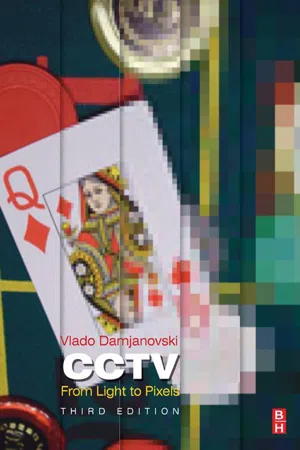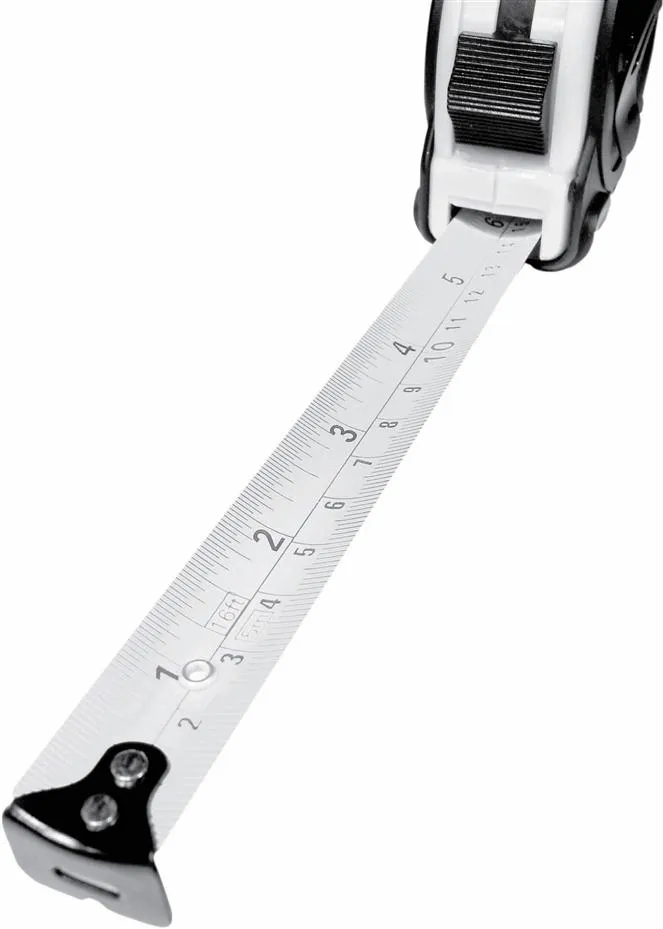
eBook - ePub
CCTV
From Light to Pixels
Vlado Damjanovski
This is a test
- 616 páginas
- English
- ePUB (apto para móviles)
- Disponible en iOS y Android
eBook - ePub
CCTV
From Light to Pixels
Vlado Damjanovski
Detalles del libro
Vista previa del libro
Índice
Citas
Información del libro
The new edition of CCTV, a high-level professional reference, is expanded to cover all video compression techniques used in the ever-increasing assortment of digital video recorders (DVRs) available on the market today. In addition to demystifying DVR technology, the third edition also clarifies the technology of data networking and explains various compression techniques. Along with all this, the book retains the particulars that made the previous editions convenient and valuable, including details of CCD cameras, lenses, coaxial cables, fiber-optics, and system design.
- Updated to address digital techniques, networking, and the Internet in closed-circuit television
- Includes brand new sections on CCTV networking, digital video recorders (DVRs), various video compression techniques, and understanding pixels and digital image quality
- Fully illustrated with dozens of photographs, tables, checklists, charts, diagrams, and instructions
Preguntas frecuentes
¿Cómo cancelo mi suscripción?
¿Cómo descargo los libros?
Por el momento, todos nuestros libros ePub adaptables a dispositivos móviles se pueden descargar a través de la aplicación. La mayor parte de nuestros PDF también se puede descargar y ya estamos trabajando para que el resto también sea descargable. Obtén más información aquí.
¿En qué se diferencian los planes de precios?
Ambos planes te permiten acceder por completo a la biblioteca y a todas las funciones de Perlego. Las únicas diferencias son el precio y el período de suscripción: con el plan anual ahorrarás en torno a un 30 % en comparación con 12 meses de un plan mensual.
¿Qué es Perlego?
Somos un servicio de suscripción de libros de texto en línea que te permite acceder a toda una biblioteca en línea por menos de lo que cuesta un libro al mes. Con más de un millón de libros sobre más de 1000 categorías, ¡tenemos todo lo que necesitas! Obtén más información aquí.
¿Perlego ofrece la función de texto a voz?
Busca el símbolo de lectura en voz alta en tu próximo libro para ver si puedes escucharlo. La herramienta de lectura en voz alta lee el texto en voz alta por ti, resaltando el texto a medida que se lee. Puedes pausarla, acelerarla y ralentizarla. Obtén más información aquí.
¿Es CCTV un PDF/ePUB en línea?
Sí, puedes acceder a CCTV de Vlado Damjanovski en formato PDF o ePUB, así como a otros libros populares de Computer Science y Computer Vision & Pattern Recognition. Tenemos más de un millón de libros disponibles en nuestro catálogo para que explores.
Información
1
SI Units of Measurement
Abstract
The Laws of Physics are expressions of fundamental relationships between certain physical quantities. Measurements are made by comparing the magnitude of a quantity with that of a given unit of that quantity. In physics, which Electronics and Television are a part of, the International system of units, known as SI (from the French SystèmeInternationale), is used.
Key Words
basic unit; derived unit; International system of units; metric prefix

The basic units
The laws of physics are expressions of fundamental relationships between certain physical quantities.
There are many different quantities in physics. In order to simplify measurement and to comply with the theory of physics, some of them are taken as basic quantities, while all others are derived from those basic ones.
Measurements are made by comparing the magnitude of a quantity with that of a given unit of that quantity.
In physics, of which electronics and television are a part, the International System of Units, known as SI (from the French Système Internationale), is used.
The following are the seven basic units:
| Unit | Symbol | Measures |
| Meter | [m] | length |
| Kilogram | [kg] | mass |
| Second | [s] | time |
| Ampere | [A] | electric current |
| Kelvin | [K] | temperature |
| Candela | [cd] | luminous intensity |
| Mole | [mol] | amount of substance |
These basic units are defined by internationally recognized standards.
The standard for meter, for example, was defined as a certain number of wavelengths of a specific radiation in the spectrum of krypton until 1983. In October 1983 it was redefined as the distance that light travels in vacuum during a time of 1/299,792,458 second.
The standard of kilogram, for example, is the mass of a particular piece of platinum-iridium alloy cylinder kept at the International Bureau of Weights and Measurements in Sèvres, France.
The basic unit of time, the second, was defined in 1967, as a “time required for a Cesium-133 atom to undergo 9,192,631,770 vibrations.”
Kelvin degrees have the same scale division as Celsius degrees, only that the starting point of 0° K is equivalent to − 273° C; this is called the absolute zero.
All other units in physics are defined with some combination of the above-mentioned basic units. For example, an area of a block of land is defined by the equation:

where a is the width of the block of land, and b is the length. If both a and b are expressed in meters [m], the product P will be expressed in [m2]. We should mention that in mathematics the multiplication is not always represented with the × sign as above, but very often a dot • is used in between the factors being multiplied, or sometimes even without a symbol at all.
We all know that speed, for example, is defined as [m/s], although we quite often use [km/h]. We can easily convert [km/h] into [m/s] by knowing ...
Índice
- Cover image
- Title page
- Table of Contents
- Copyright
- Preface to this edition
- Introduction
- 1. SI Units of Measurement
- 2. Light and Television
- 3. Optics in CCTV
- 4. General About TV Systems
- 5. CCTV Cameras
- 6. Displays
- 7. Analog Video Processing
- 8. Digital CCTV
- 9. Video Management Systems
- 10. Transmission Media
- 11. Networking in CCTV
- 12. Auxiliary Equipment in CCTV
- 13. CCTV System Design
- 14. Video Testing
- Appendix A
- Appendix B
- Appendix C
- Appendix D
- Index
Estilos de citas para CCTV
APA 6 Citation
Damjanovski, V. (2013). CCTV (3rd ed.). Elsevier Science. Retrieved from https://www.perlego.com/book/1831366/cctv-from-light-to-pixels-pdf (Original work published 2013)
Chicago Citation
Damjanovski, Vlado. (2013) 2013. CCTV. 3rd ed. Elsevier Science. https://www.perlego.com/book/1831366/cctv-from-light-to-pixels-pdf.
Harvard Citation
Damjanovski, V. (2013) CCTV. 3rd edn. Elsevier Science. Available at: https://www.perlego.com/book/1831366/cctv-from-light-to-pixels-pdf (Accessed: 15 October 2022).
MLA 7 Citation
Damjanovski, Vlado. CCTV. 3rd ed. Elsevier Science, 2013. Web. 15 Oct. 2022.